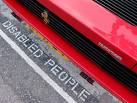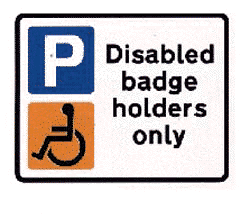How to make the world a better place?

How to make the environment a better place for disabled people?
As 100% physically able citizen, I must confess, I have never thought about the concerns that disabled people may have with their daily life. This was invisible to me, until the day I had to carry my baby’s trolley and got frequently detained by barriers that where always there, but because of my new condition they became very annoying.
There are two kinds of barriers that must be avoided in big cities all over the world:
Physical/Design Barriers
Mobility Barriers
For the first kind of barriers: every citizen should think that, everyone should be able to get to, and use, buildings and the open spaces between them. For many people this is not currently possible due to barriers created by the design, management and operation of buildings, streets and open space. As a simple driver or as responsible architect, people should think of barriers to others.
Let me give some examples:
· Parking anarchy in big cities.
· Holes in pavement.
· Access to buildings by stairs.
· Heavy or stiffly sprung doors.
· Ramps in the side walks.
 Much is already being done, to address problems facing disabled people when using public buildings and open space in order to eliminate barriers. But much is still to be done, mainly in our conscience.
Much is already being done, to address problems facing disabled people when using public buildings and open space in order to eliminate barriers. But much is still to be done, mainly in our conscience.Architects must look to Inclusive design as an approach that sets out to include as many people as possible and tries to break down unnecessary barriers and exclusion. In doing so, it will often achieve superior solutions that benefit everyone.
But even in new buildings disabled people experience barriers to access.
There are other requirements like Building Regulations for housing services providers and regulators of the building industry. Planning authorities should be advised by commissions to consider the needs of disabled people.
But, is not only about design, it is also about how places are planned, managed and operated that affects access for disabled people, and this has to do with our conscience.
In concerning to mobility, many disabled people rely on cars for getting about. Whether they drive themselves or ride with someone else, the easiest way they can reach their destination is almost always determined by where the car can be parked. Parking bays for disabled people should be conveniently located and clearly signed.
As pedestrians, many disabled people have a limited mobility range, and require specially designated parking bays closer to the places they wish to visit. Whether on-street or off-street, parking bays for disabled people should not be further from major destinations (e.g. bank, post office, shopping center, supermarket).

This leaflet gives advice to local authorities and car park owners and operators. It is intended to help them in providing for those with all types of mobility difficulty who wish to park on the street. Authorities must respect it and punish those who don’t.
In public transportations, signs are essential, whether they are visual or sound signs. For instance: If the buses are not wheelchair accessible, this should be clearly advertised.
Pedestrian routes to and from public transportation with bays for disabled people should be free from steps, where steps are necessary, they should have edges with a strong colour contrast and be well lit. Pedestrian ramps should also be provided; they should be short, preferably with gradients no steeper than 5%. Handrails should be provided on both sides of ramps and steps, where the vertical distance is too great for a ramp, lifts must be used but they must have automatic doors. Access ways should be wide enough for all lift users and seats should be provided close to lift entrances for those who are unable to stand for long periods. Waiting areas should be well lit. It is essential that lifts are well maintained and reliable.
Any control equipment should be placed at a suitable height for disabled people to see and use it, a suitable height for coin slots, elevator controls, displays and instructions is between 1000 mm and 1400 mm above the ground.
Conclusion:
Much has still to be done to prevent the discrimination of disabled people and provide equality of access to goods, facilities and services. Everyone has responsibility, even if a citizen is not a disabled person, he ought to:
Provide feedback to authorities - positive and negative - on access provision to the buildings and public transportations.
Provide feedback to authorities about parking violations that are addressed barriers to disabled people.
Force governors to legislate about disability discrimination.

